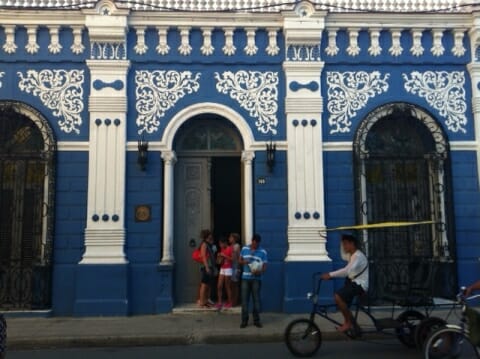
Aug 13, 2015 | Focolare Worldwide
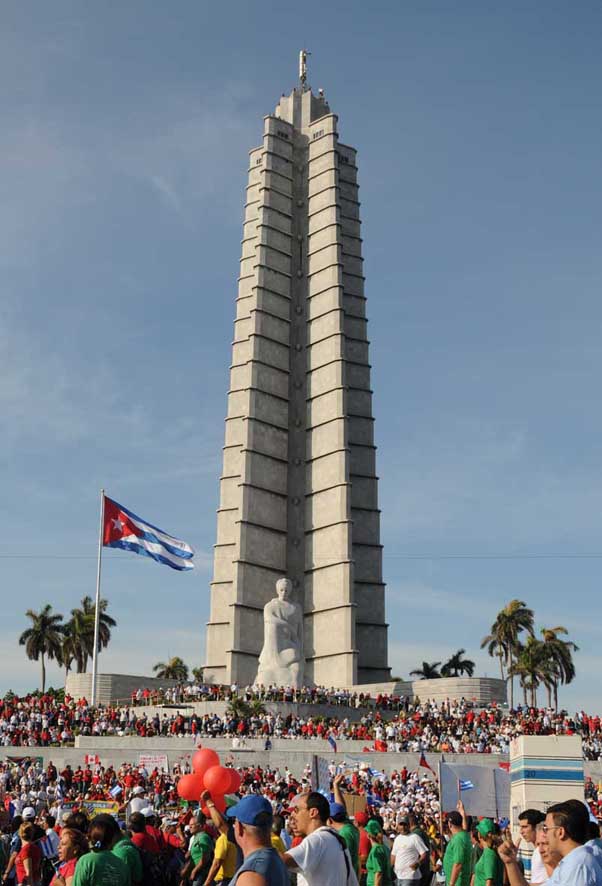
Revolution Square and José Martí Memorial
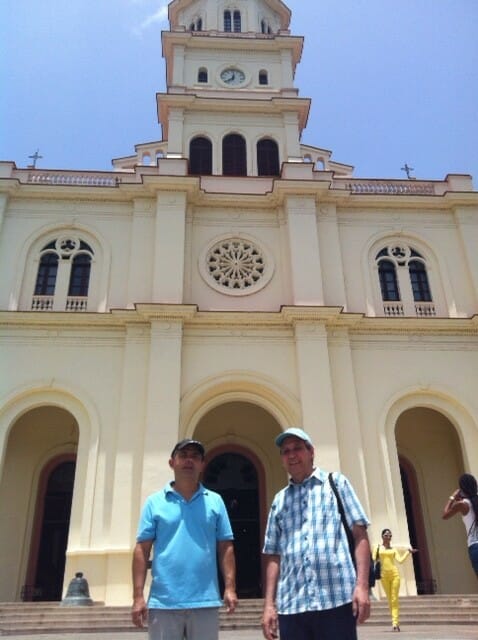
the National Shrine of the Virgin of Charity of Cobre
 The Focolare Movement’s contribution. The Focolare communities across the island are trying – together with the Church – to offer its own contribution, geared mainly towards formation in fraternity in opposition to the “throw-away culture”, to privileging those in most need, promoting unity in diversity and proposing dialogue as an indispensable method for peaceful coexistence in a multicultural society. Conclusion. The message of the Cuban Catholic Bishops concludes with a prayer to the Virgin of Charity, Mother of Cuba, the One whom we invoke as Mother and Queen of Mercy, that she might take maternal care of this longed-for visit. She who has accompanied our people in good times and in bad, may she obtain a great blessing from Heaven for Cuba and her children wherever they may be, whatever they may think or believe.” From an interview with correspondent Gustavo Clariá _____________________ [1] Castellano Dennys, Sergio L. and Monterrey, Fontanella. Sin pecado concebidas, La Caridad del Cobre en las artes visuales cubanas, (Havana: Editorial UH, 2014), p. 66. (Our translation.)
The Focolare Movement’s contribution. The Focolare communities across the island are trying – together with the Church – to offer its own contribution, geared mainly towards formation in fraternity in opposition to the “throw-away culture”, to privileging those in most need, promoting unity in diversity and proposing dialogue as an indispensable method for peaceful coexistence in a multicultural society. Conclusion. The message of the Cuban Catholic Bishops concludes with a prayer to the Virgin of Charity, Mother of Cuba, the One whom we invoke as Mother and Queen of Mercy, that she might take maternal care of this longed-for visit. She who has accompanied our people in good times and in bad, may she obtain a great blessing from Heaven for Cuba and her children wherever they may be, whatever they may think or believe.” From an interview with correspondent Gustavo Clariá _____________________ [1] Castellano Dennys, Sergio L. and Monterrey, Fontanella. Sin pecado concebidas, La Caridad del Cobre en las artes visuales cubanas, (Havana: Editorial UH, 2014), p. 66. (Our translation.)
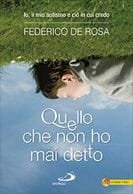
Aug 12, 2015 | Focolare Worldwide, Senza categoria
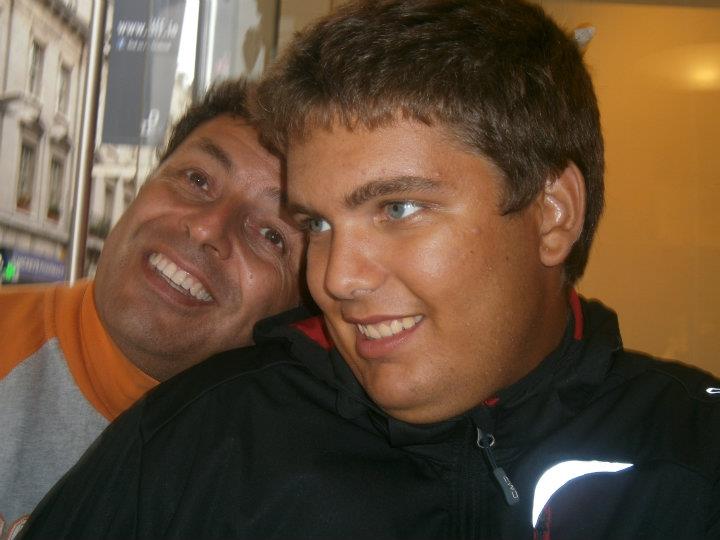
Federico with his Dad
 Now that he could write, his self-esteem grew, up to when he published a book Quello che non ho mai detto (“The words I have never said”) wherein, for the first time we can see the point of view of a boy who explains his syndrome with rare and precious observations. This is how he emerged from his isolation, and finally experienced the joy of sharing his emotions. He concluded his studies in science up to secondary school certificate stage. To this day, Federico says almost nothing. “I assure you,” he wrote, ” that I am almost unable to speak verbally. I express myself with single words, and only rarely with a small phrase. I can write only in big and shaky capital letters.” And thanks to the computer, for the first time he was able to play with a friend and attend, together with his classmates, the first year of secondary school, and years later, participate “actively” in the meetings of the confirmation group. “Little by little, ” he recounts, “my laptop became an inseparable companion. With my computer and the support of a qualified person at my side, I can express my views in every situation.” Today Federico studies percussion, has many friends, helps people with autism in their families with down to earth suggestions, and has a lot of plans for the future. “Now my life has found its course,” he wrote, “thanks to the operators who taught me how to use the system, and my parents who launched themselves in this adventure with enthusiasm. Today I am happy with my life, and a great part of the merit goes to them.” But he’s not thinking just of himself: “How many autistic people could have become other Federicos if diagnosed properly and given early intervention and been greatly loved and supported?”. His dream for the future? “I wish to travel the world to meet families with infants who have a communication disorder, to try and interact with these children and to treat autism accordingly. Whenever a child needs me, I’ll be there to help.” Source: Città Nuova online
Now that he could write, his self-esteem grew, up to when he published a book Quello che non ho mai detto (“The words I have never said”) wherein, for the first time we can see the point of view of a boy who explains his syndrome with rare and precious observations. This is how he emerged from his isolation, and finally experienced the joy of sharing his emotions. He concluded his studies in science up to secondary school certificate stage. To this day, Federico says almost nothing. “I assure you,” he wrote, ” that I am almost unable to speak verbally. I express myself with single words, and only rarely with a small phrase. I can write only in big and shaky capital letters.” And thanks to the computer, for the first time he was able to play with a friend and attend, together with his classmates, the first year of secondary school, and years later, participate “actively” in the meetings of the confirmation group. “Little by little, ” he recounts, “my laptop became an inseparable companion. With my computer and the support of a qualified person at my side, I can express my views in every situation.” Today Federico studies percussion, has many friends, helps people with autism in their families with down to earth suggestions, and has a lot of plans for the future. “Now my life has found its course,” he wrote, “thanks to the operators who taught me how to use the system, and my parents who launched themselves in this adventure with enthusiasm. Today I am happy with my life, and a great part of the merit goes to them.” But he’s not thinking just of himself: “How many autistic people could have become other Federicos if diagnosed properly and given early intervention and been greatly loved and supported?”. His dream for the future? “I wish to travel the world to meet families with infants who have a communication disorder, to try and interact with these children and to treat autism accordingly. Whenever a child needs me, I’ll be there to help.” Source: Città Nuova online
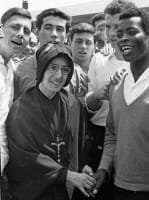
Aug 11, 2015 | Focolare Worldwide
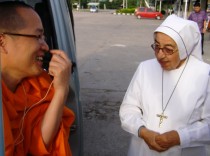 Several Buddhist monks that visited the focolare regularly also knew her well. Benedetta was a woman who let herself be approached and known, without fear and with gentleness. She knew how to welcome people and you could go to her any time. Any problem, great or small, any need, some good news to share: she wasn’t scandalised by anything, she knew people’s hearts and knew how to love them. One bishop once said of Sister Benedetta that she was “a Sister of silver and gold” because of all the money she was able to find for the poor. When visiting the extreme north of Thailand, you were always obliged to go and ‘have a chat’ with her, as she would say. She enjoyed hearing the news of her ‘great family’ as she loved to call the Movement, and she shared its life with many others. We would often meet people in the Mariapolis to whom she had spoken about the spirituality of unity, or else someone who had passed by the focolare to meet us because they had heard Sister Bene talk about us. In other words, Benedetta was a true spiritual mother who gave much supernatural life to so many people, and many of them attended her funeral along with a large crowd of bishops, priests and laity. The small church of Wien Pa Pao and the adjoining convent where she lived were filled to overflowing.
Several Buddhist monks that visited the focolare regularly also knew her well. Benedetta was a woman who let herself be approached and known, without fear and with gentleness. She knew how to welcome people and you could go to her any time. Any problem, great or small, any need, some good news to share: she wasn’t scandalised by anything, she knew people’s hearts and knew how to love them. One bishop once said of Sister Benedetta that she was “a Sister of silver and gold” because of all the money she was able to find for the poor. When visiting the extreme north of Thailand, you were always obliged to go and ‘have a chat’ with her, as she would say. She enjoyed hearing the news of her ‘great family’ as she loved to call the Movement, and she shared its life with many others. We would often meet people in the Mariapolis to whom she had spoken about the spirituality of unity, or else someone who had passed by the focolare to meet us because they had heard Sister Bene talk about us. In other words, Benedetta was a true spiritual mother who gave much supernatural life to so many people, and many of them attended her funeral along with a large crowd of bishops, priests and laity. The small church of Wien Pa Pao and the adjoining convent where she lived were filled to overflowing.  Sr Bene, of the Sisters of Charity of the Infant Mary, known to the secular world as Benedetta Carnovali, born in 1925, was a pillar of the Movement and many of the people who belong to the Focolare community of Thailand were personally drawn to the Movement by her (including Buddhists). ‘A real Sister and a true focolarina,’ as she was described by some: an ‘out-of-the-ordinary’ Sister, always on the go and, at the same time, ‘firm’ when personally loving the person next to her. She was a friend who would call you up to wish you a happy birthday, even though her voice became feebler every year, but not her interior strength. Whenever you approached her you were never given the impression that you had disturbed her: it was as if she had been expecting you alone and didn’t have anything else to do but welcome you. But she was quite busy, judging from all the adoptions at a distance which she personally saw to, up until the last days of her life. Sister Bene had met the Focolare’s spirituality of unity from an order priest in 1963, and from that moment spent her life that many in Myanmar – where she was living in that period and then in Thailand when all Religious were expelled by the regime – could know the spirituality and live it. When she was transferred to Thailand, she continued to deepen her friendship with the Focolare. When she went to spend a few days at the focolare, she nourished herself on the words of Chiara Lubich. Like all those who genuinely follow God, Sister Benedetta also encountered her nights, ‘the storm’ as she followed Jesus. She faced them as a true disciple of Jesus, with heroic charity. Deeply united with Vale Ronchetti, one of the first focolarine, she pressed on in the midst of much miscomprehension: ‘How can a nun belong to a movement with so many lay people in it?’ she was often asked; and there were other great and small persecutions that on a human level were completely absurd. Yet, in some mysterious way, God made use of these things to make Sister Benedetta more and more a Sister, more and more a spiritual daughter of Chiara (as Benedetta often said), and an apostle of unity who has no counterpart in the Asian southeast judging from the fruits she bore. She leaves a legacy of love, gentleness, sweetness and strength, loving service to the least: towards the people of the Akha tribe, for example. She leaves us withthat smile so typical of those who have experienced that it is possible to transform suffering in Love and make that Love their reason for living. Sister Benedetta ‘flew” to Heaven at the age of ninety, after listening to the Focolare song that she loved: ‘Solo grazie’. She died consumed but serene, just as she had always lived: in peace because she was certain that the ‘arms’ that had embraced her from her childhood (she was an orphan) and carried her through her life as a Religious, were there waiting for her now on this last stretch of her journey. She was a wonderful woman who shows that it is still possible to become a saint today. Luigi Butori
Sr Bene, of the Sisters of Charity of the Infant Mary, known to the secular world as Benedetta Carnovali, born in 1925, was a pillar of the Movement and many of the people who belong to the Focolare community of Thailand were personally drawn to the Movement by her (including Buddhists). ‘A real Sister and a true focolarina,’ as she was described by some: an ‘out-of-the-ordinary’ Sister, always on the go and, at the same time, ‘firm’ when personally loving the person next to her. She was a friend who would call you up to wish you a happy birthday, even though her voice became feebler every year, but not her interior strength. Whenever you approached her you were never given the impression that you had disturbed her: it was as if she had been expecting you alone and didn’t have anything else to do but welcome you. But she was quite busy, judging from all the adoptions at a distance which she personally saw to, up until the last days of her life. Sister Bene had met the Focolare’s spirituality of unity from an order priest in 1963, and from that moment spent her life that many in Myanmar – where she was living in that period and then in Thailand when all Religious were expelled by the regime – could know the spirituality and live it. When she was transferred to Thailand, she continued to deepen her friendship with the Focolare. When she went to spend a few days at the focolare, she nourished herself on the words of Chiara Lubich. Like all those who genuinely follow God, Sister Benedetta also encountered her nights, ‘the storm’ as she followed Jesus. She faced them as a true disciple of Jesus, with heroic charity. Deeply united with Vale Ronchetti, one of the first focolarine, she pressed on in the midst of much miscomprehension: ‘How can a nun belong to a movement with so many lay people in it?’ she was often asked; and there were other great and small persecutions that on a human level were completely absurd. Yet, in some mysterious way, God made use of these things to make Sister Benedetta more and more a Sister, more and more a spiritual daughter of Chiara (as Benedetta often said), and an apostle of unity who has no counterpart in the Asian southeast judging from the fruits she bore. She leaves a legacy of love, gentleness, sweetness and strength, loving service to the least: towards the people of the Akha tribe, for example. She leaves us withthat smile so typical of those who have experienced that it is possible to transform suffering in Love and make that Love their reason for living. Sister Benedetta ‘flew” to Heaven at the age of ninety, after listening to the Focolare song that she loved: ‘Solo grazie’. She died consumed but serene, just as she had always lived: in peace because she was certain that the ‘arms’ that had embraced her from her childhood (she was an orphan) and carried her through her life as a Religious, were there waiting for her now on this last stretch of her journey. She was a wonderful woman who shows that it is still possible to become a saint today. Luigi Butori
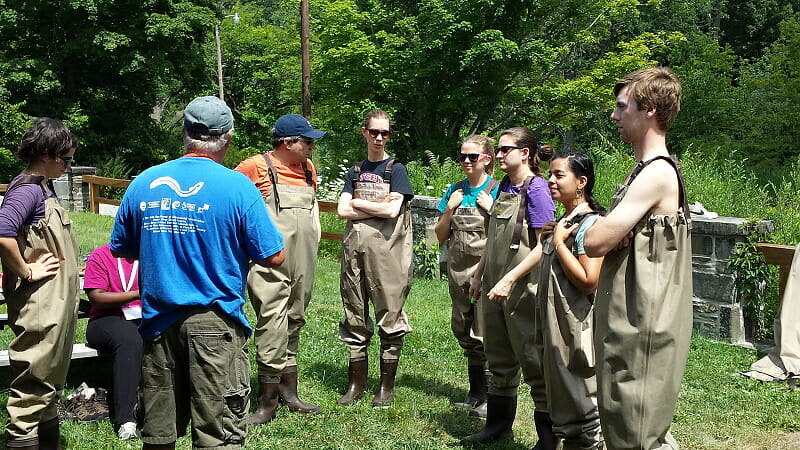
Aug 10, 2015 | Focolare Worldwide
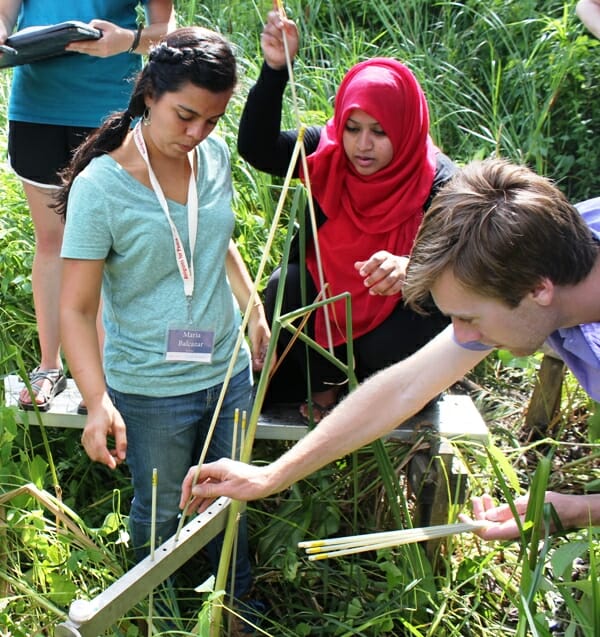 Young people from five religions and several Christian denomination, specifically chosen as emergent leaders in the environmental field, met at Mariapolis Luminosa of the Focolare in the State of New York, USA, to reflect on safeguarding the planet, our common home. Guided by the ideals of Religions for Peace (RFP) and of the Focolare the Teach-in began with an analysis of the current situation of the environment and the strong link between global stability and climate change. The phenomenon of climate change calls for a new awareness and change of view, implied by the title of the three-day event. Perhaps it will find a solution thanks to the synergy between people from different religious backgrounds. This was the wish of the organisers of Teach-in, which was held at the end of July 2015. Despite the variety of their beliefs they came to the same realisation that every effort in favor of the environment will be more efficacious inasmuch as it is done together. Amongst the interventions were those of Rev. Richard Cizik (New Evangelical Partnership) and of the Rabbi Lawrence Troster, bioethicist who said that: “By 2050 we could have 50 million climate refugees, with serious consequences for peaceful coexistence amongst peoples.” His words were echoed by Asma Mahdi, oceanographer and member of Green Muslims, highlighting that the most vulnerable countries are Muslim: “In Bangladesh, for example, if the ocean level continues to rise, by 2050, 17% of the territory will be awash, forcing 18 million people to move elsewhere.” These are alarming figures, and several Polynesian islands would completely submerged.
Young people from five religions and several Christian denomination, specifically chosen as emergent leaders in the environmental field, met at Mariapolis Luminosa of the Focolare in the State of New York, USA, to reflect on safeguarding the planet, our common home. Guided by the ideals of Religions for Peace (RFP) and of the Focolare the Teach-in began with an analysis of the current situation of the environment and the strong link between global stability and climate change. The phenomenon of climate change calls for a new awareness and change of view, implied by the title of the three-day event. Perhaps it will find a solution thanks to the synergy between people from different religious backgrounds. This was the wish of the organisers of Teach-in, which was held at the end of July 2015. Despite the variety of their beliefs they came to the same realisation that every effort in favor of the environment will be more efficacious inasmuch as it is done together. Amongst the interventions were those of Rev. Richard Cizik (New Evangelical Partnership) and of the Rabbi Lawrence Troster, bioethicist who said that: “By 2050 we could have 50 million climate refugees, with serious consequences for peaceful coexistence amongst peoples.” His words were echoed by Asma Mahdi, oceanographer and member of Green Muslims, highlighting that the most vulnerable countries are Muslim: “In Bangladesh, for example, if the ocean level continues to rise, by 2050, 17% of the territory will be awash, forcing 18 million people to move elsewhere.” These are alarming figures, and several Polynesian islands would completely submerged. 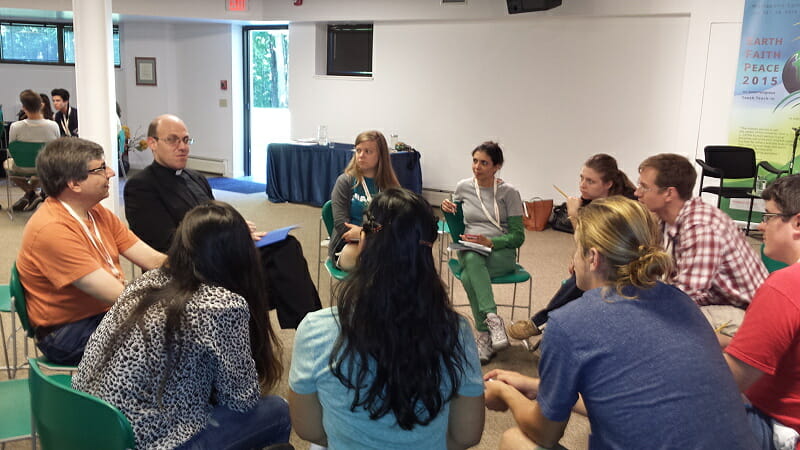 Amongst the speakers was Msgr. Joseph Grech from the Permanent Observer Mission of the Holy See to the United Nations, who referred to several excerpts from Pope Francis’s Encyclical Letter Laudato si while underscoring how economy and ecology walk hand in hand, since all our actions have an impact on nature. Three environmental researchers from three different American universities were of the same opinon: Robert Yantosca (Harvard), Valentine Nzengung (Georgia) and Tasrunji Singh (Ohio), for whom the respective religious convictions have become motivating factors and guides in the scientific effort in favour of the environment.
Amongst the speakers was Msgr. Joseph Grech from the Permanent Observer Mission of the Holy See to the United Nations, who referred to several excerpts from Pope Francis’s Encyclical Letter Laudato si while underscoring how economy and ecology walk hand in hand, since all our actions have an impact on nature. Three environmental researchers from three different American universities were of the same opinon: Robert Yantosca (Harvard), Valentine Nzengung (Georgia) and Tasrunji Singh (Ohio), for whom the respective religious convictions have become motivating factors and guides in the scientific effort in favour of the environment.  “Go out!” was the catch phrase that conducted the second part of the Teach-in and it led to the delineation of a series of behaviours to put into practice. John Mundell from the Focolare, owner of a company of environmental consultants, presented a landscape of initiatives connected to the “Earth Cube,” whose six sides present daily suggestions for renewing and conserving a healthy environment. There was also the visit to the projects at the nearby Esaurine Federal Reserve. RFP executive Aaron Stauffer, stated at the conclusion: “It has been a witness of the power of multireligious cooperation and peace.” And Brazilian, Lira Raiana, who is finishing her doctorate in ecology: “We’ve experienced that we have at least two things in common: an intense interest in sustainability of the planet and a religious belief that offers the correct motivations to take care of it. Each one of us came with our convictions and personal ideas and now we find ourselves united in the common objective of many: the protection of the earth and of its inhabitants.”
“Go out!” was the catch phrase that conducted the second part of the Teach-in and it led to the delineation of a series of behaviours to put into practice. John Mundell from the Focolare, owner of a company of environmental consultants, presented a landscape of initiatives connected to the “Earth Cube,” whose six sides present daily suggestions for renewing and conserving a healthy environment. There was also the visit to the projects at the nearby Esaurine Federal Reserve. RFP executive Aaron Stauffer, stated at the conclusion: “It has been a witness of the power of multireligious cooperation and peace.” And Brazilian, Lira Raiana, who is finishing her doctorate in ecology: “We’ve experienced that we have at least two things in common: an intense interest in sustainability of the planet and a religious belief that offers the correct motivations to take care of it. Each one of us came with our convictions and personal ideas and now we find ourselves united in the common objective of many: the protection of the earth and of its inhabitants.”

Aug 8, 2015 | Focolare Worldwide
 Geneva, Switzerland, Rue de Montbrillant, n. 3. Like every other Friday I go to Jardin de Montbrillant, a welcome centre for needy people in this cosmopolitan city where you can have a free hot meal. Today, as always, at noontime, we welcome around 150 people of every nationality. The room is already full and everything is going fine. Amidst the usual faces in the diverse crowd I always notice someone new. My task is to find a place for each of them, to negotiate with one or another so that they will allow someone new to have a place to sit and eat in peace, which isn’t always easy given the physical and psychological state of many of the majority of our guests. But I’m mainly interested in giving a fraternal touch, to comfort the ones who are sad, depressed – to listen to the ones who feel desperate, to offer them some hope. . . In other words, to create a family atmosphere so that everyone feels loved just the way they are, beyond the diversity of ages, nationalities and religions. While we’re at table, the door opens and three of our Arab friends arrive accompanied by two newcomers. I immediately notice the hard, threatening looks on their faces. As soon as they are inside, they begin shouting that they want to massacre everyone and burn the place to the ground. The reason: they feel seriously offended by the caricatures of the Prophet that appeared previous days in the press, the main news of the week. The atmosphere immediately becomes tense and people propose violence. I already see plates flying and fists showering down blows. It’s time to act without delay, because the situation could quickly worsen. But what shall I say? What shall I do? I feel powerless but recognise in this acute suffering of today’s society that defends absolute freedom at the expense of deep values, the cry of the God-Man upon the Cross: “My God, my God, why have you abandoned me?” This is Him before me now, through the reaction of this pair of Muslim followers. I place everything in His hands and stand up to go and meet them. I tell them that I share their pain and offer to talk about it after having something to eat if they would care to. In answer to my peaceful offer they allow themselves to be convinced to take a place at table. Suddenly their aggressiveness abates and tranquility returns, as if everyone perfectly understood the cause of their angry outburst. Lunch ends peacefully. I stay near them, trying to make them feel all the human warmth that I’m capable of. After lunch they apologize for their words and express regret for having voiced thoughts of revenge. This is followed by a moment of sharing about our respective faiths in total respect and mutual understanding. Before leaving, they embrace me, thankful for having been listened to. Now their relaxed faces express different sentiments than before. (Paquita Nosal – Geneva, Switzerland) Source: Città Nuova, 13/14, (2015).
Geneva, Switzerland, Rue de Montbrillant, n. 3. Like every other Friday I go to Jardin de Montbrillant, a welcome centre for needy people in this cosmopolitan city where you can have a free hot meal. Today, as always, at noontime, we welcome around 150 people of every nationality. The room is already full and everything is going fine. Amidst the usual faces in the diverse crowd I always notice someone new. My task is to find a place for each of them, to negotiate with one or another so that they will allow someone new to have a place to sit and eat in peace, which isn’t always easy given the physical and psychological state of many of the majority of our guests. But I’m mainly interested in giving a fraternal touch, to comfort the ones who are sad, depressed – to listen to the ones who feel desperate, to offer them some hope. . . In other words, to create a family atmosphere so that everyone feels loved just the way they are, beyond the diversity of ages, nationalities and religions. While we’re at table, the door opens and three of our Arab friends arrive accompanied by two newcomers. I immediately notice the hard, threatening looks on their faces. As soon as they are inside, they begin shouting that they want to massacre everyone and burn the place to the ground. The reason: they feel seriously offended by the caricatures of the Prophet that appeared previous days in the press, the main news of the week. The atmosphere immediately becomes tense and people propose violence. I already see plates flying and fists showering down blows. It’s time to act without delay, because the situation could quickly worsen. But what shall I say? What shall I do? I feel powerless but recognise in this acute suffering of today’s society that defends absolute freedom at the expense of deep values, the cry of the God-Man upon the Cross: “My God, my God, why have you abandoned me?” This is Him before me now, through the reaction of this pair of Muslim followers. I place everything in His hands and stand up to go and meet them. I tell them that I share their pain and offer to talk about it after having something to eat if they would care to. In answer to my peaceful offer they allow themselves to be convinced to take a place at table. Suddenly their aggressiveness abates and tranquility returns, as if everyone perfectly understood the cause of their angry outburst. Lunch ends peacefully. I stay near them, trying to make them feel all the human warmth that I’m capable of. After lunch they apologize for their words and express regret for having voiced thoughts of revenge. This is followed by a moment of sharing about our respective faiths in total respect and mutual understanding. Before leaving, they embrace me, thankful for having been listened to. Now their relaxed faces express different sentiments than before. (Paquita Nosal – Geneva, Switzerland) Source: Città Nuova, 13/14, (2015).

Aug 3, 2015 | Focolare Worldwide, Senza categoria
 Baobab is one of many refugees welcoming centers, near the Tiburtina train station. It welcomes some 400 young Eritrean, Somali and Sudanese Christians and Muslims. “There’s a warm, happy chaotic and rather anarchical volunteer service – says S. – everyone goes, sees what is needed, helps, calls friends . . . And it works just fine! With the consent of the people in charge of the Food Bank of Rome, together with a young woman who coordinates the volunteers from the Baobab Centre, we went to Fiano Romano and packed twenty tons of excellent food (pasta, sugar, canned meats, 600 yogurts, cases of oil, 120 pineapples, 30 cases of fresh fish and nectarines, 100 pieces of parmesan cheese, and much more). By ten o’clock it was already 40°C (104°F)! We got to the centre at around 13:00, where we found at least 500 quite organised and patient Eritrean youngsters, all of them from those notorious boats that we see on the television news. The temperature was at least 42°C by then. In the span of ten minutes or so, the children formed a queue, and began to unload an overpacked van. Not a single yogurt or drink was taken, and everything was carefully placed in its proper place. Then they all entered the queue for lunch. I was also served a plate, which I was happy to share with them. The welcome centre does not only focus on assistance, but especially on involving and integrating the refugees. This ensures that the individual dignity of each person will be respected and that each of them is welcomed and accepted. Many of them then contact relatives and friends in other European countries. The long line of Roman citizens who bring all sorts of help is constant and also quite moving. So much assistance arrives that we often take boxes of supplies to other assistance centres. As I was there shaking hands and meeting people, the first baby was born to a young refugee woman who had been taken in by the centre. She had just arrived from the hospital, 20 days old. Doctors, nurses, volunteers all gathered around her for a smile, hoping to get a glimpse of her face. It showed how life goes on. I returned home more tired and sweaty than I ever have before. . . but in my heart and soul there was a unique and quite special joy, such tangible serenity, the true recompense for a small gesture toward those beautiful people whom everyone is calling “refugees”. . . At the end of the month we’re already planning on taking another load of supplies. Moreover, through a friend whose family runs five supermarkets, we were able to organize regular food pick-ups of products whose expiration dates would soon expire but could be consumed within a few days at the welcome centre. I thank the Eritrean refugees and volunteers at the Baobab Camp for having given me the opportunity to live a truly beautiful and precious moment, which I am sure will happen again in the coming days and in the future. I feel so privileged, and I truly am!” (S.D. Italy)
Baobab is one of many refugees welcoming centers, near the Tiburtina train station. It welcomes some 400 young Eritrean, Somali and Sudanese Christians and Muslims. “There’s a warm, happy chaotic and rather anarchical volunteer service – says S. – everyone goes, sees what is needed, helps, calls friends . . . And it works just fine! With the consent of the people in charge of the Food Bank of Rome, together with a young woman who coordinates the volunteers from the Baobab Centre, we went to Fiano Romano and packed twenty tons of excellent food (pasta, sugar, canned meats, 600 yogurts, cases of oil, 120 pineapples, 30 cases of fresh fish and nectarines, 100 pieces of parmesan cheese, and much more). By ten o’clock it was already 40°C (104°F)! We got to the centre at around 13:00, where we found at least 500 quite organised and patient Eritrean youngsters, all of them from those notorious boats that we see on the television news. The temperature was at least 42°C by then. In the span of ten minutes or so, the children formed a queue, and began to unload an overpacked van. Not a single yogurt or drink was taken, and everything was carefully placed in its proper place. Then they all entered the queue for lunch. I was also served a plate, which I was happy to share with them. The welcome centre does not only focus on assistance, but especially on involving and integrating the refugees. This ensures that the individual dignity of each person will be respected and that each of them is welcomed and accepted. Many of them then contact relatives and friends in other European countries. The long line of Roman citizens who bring all sorts of help is constant and also quite moving. So much assistance arrives that we often take boxes of supplies to other assistance centres. As I was there shaking hands and meeting people, the first baby was born to a young refugee woman who had been taken in by the centre. She had just arrived from the hospital, 20 days old. Doctors, nurses, volunteers all gathered around her for a smile, hoping to get a glimpse of her face. It showed how life goes on. I returned home more tired and sweaty than I ever have before. . . but in my heart and soul there was a unique and quite special joy, such tangible serenity, the true recompense for a small gesture toward those beautiful people whom everyone is calling “refugees”. . . At the end of the month we’re already planning on taking another load of supplies. Moreover, through a friend whose family runs five supermarkets, we were able to organize regular food pick-ups of products whose expiration dates would soon expire but could be consumed within a few days at the welcome centre. I thank the Eritrean refugees and volunteers at the Baobab Camp for having given me the opportunity to live a truly beautiful and precious moment, which I am sure will happen again in the coming days and in the future. I feel so privileged, and I truly am!” (S.D. Italy)

 The Focolare Movement’s contribution. The Focolare communities across the island are trying – together with the Church – to offer its own contribution, geared mainly towards formation in fraternity in opposition to the “throw-away culture”, to privileging those in most need, promoting unity in diversity and proposing dialogue as an indispensable method for peaceful coexistence in a multicultural society. Conclusion. The message of the Cuban Catholic Bishops concludes with a prayer to the Virgin of Charity, Mother of Cuba, the One whom we invoke as Mother and Queen of Mercy, that she might take maternal care of this longed-for visit. She who has accompanied our people in good times and in bad, may she obtain a great blessing from Heaven for Cuba and her children wherever they may be, whatever they may think or believe.” From an interview with correspondent Gustavo Clariá _____________________ [1] Castellano Dennys, Sergio L. and Monterrey, Fontanella. Sin pecado concebidas, La Caridad del Cobre en las artes visuales cubanas, (Havana: Editorial UH, 2014), p. 66. (Our translation.)
The Focolare Movement’s contribution. The Focolare communities across the island are trying – together with the Church – to offer its own contribution, geared mainly towards formation in fraternity in opposition to the “throw-away culture”, to privileging those in most need, promoting unity in diversity and proposing dialogue as an indispensable method for peaceful coexistence in a multicultural society. Conclusion. The message of the Cuban Catholic Bishops concludes with a prayer to the Virgin of Charity, Mother of Cuba, the One whom we invoke as Mother and Queen of Mercy, that she might take maternal care of this longed-for visit. She who has accompanied our people in good times and in bad, may she obtain a great blessing from Heaven for Cuba and her children wherever they may be, whatever they may think or believe.” From an interview with correspondent Gustavo Clariá _____________________ [1] Castellano Dennys, Sergio L. and Monterrey, Fontanella. Sin pecado concebidas, La Caridad del Cobre en las artes visuales cubanas, (Havana: Editorial UH, 2014), p. 66. (Our translation.)











 Geneva, Switzerland, Rue de Montbrillant, n. 3. Like every other Friday I go to Jardin de Montbrillant, a welcome centre for needy people in this cosmopolitan city where you can have a free hot meal. Today, as always, at noontime, we welcome around 150 people of every nationality. The room is already full and everything is going fine. Amidst the usual faces in the diverse crowd I always notice someone new. My task is to find a place for each of them, to negotiate with one or another so that they will allow someone new to have a place to sit and eat in peace, which isn’t always easy given the physical and psychological state of many of the majority of our guests. But I’m mainly interested in giving a fraternal touch, to comfort the ones who are sad, depressed – to listen to the ones who feel desperate, to offer them some hope. . . In other words, to create a family atmosphere so that everyone feels loved just the way they are, beyond the diversity of ages, nationalities and religions. While we’re at table, the door opens and three of our Arab friends arrive accompanied by two newcomers. I immediately notice the hard, threatening looks on their faces. As soon as they are inside, they begin shouting that they want to massacre everyone and burn the place to the ground. The reason: they feel seriously offended by the caricatures of the Prophet that appeared previous days in the press, the main news of the week. The atmosphere immediately becomes tense and people propose violence. I already see plates flying and fists showering down blows. It’s time to act without delay, because the situation could quickly worsen. But what shall I say? What shall I do? I feel powerless but recognise in this acute suffering of today’s society that defends absolute freedom at the expense of deep values, the cry of the God-Man upon the Cross: “My God, my God, why have you abandoned me?” This is Him before me now, through the reaction of this pair of Muslim followers. I place everything in His hands and stand up to go and meet them. I tell them that I share their pain and offer to talk about it after having something to eat if they would care to. In answer to my peaceful offer they allow themselves to be convinced to take a place at table. Suddenly their aggressiveness abates and tranquility returns, as if everyone perfectly understood the cause of their angry outburst. Lunch ends peacefully. I stay near them, trying to make them feel all the human warmth that I’m capable of. After lunch they apologize for their words and express regret for having voiced thoughts of revenge. This is followed by a moment of sharing about our respective faiths in total respect and mutual understanding. Before leaving, they embrace me, thankful for having been listened to. Now their relaxed faces express different sentiments than before. (Paquita Nosal –
Geneva, Switzerland, Rue de Montbrillant, n. 3. Like every other Friday I go to Jardin de Montbrillant, a welcome centre for needy people in this cosmopolitan city where you can have a free hot meal. Today, as always, at noontime, we welcome around 150 people of every nationality. The room is already full and everything is going fine. Amidst the usual faces in the diverse crowd I always notice someone new. My task is to find a place for each of them, to negotiate with one or another so that they will allow someone new to have a place to sit and eat in peace, which isn’t always easy given the physical and psychological state of many of the majority of our guests. But I’m mainly interested in giving a fraternal touch, to comfort the ones who are sad, depressed – to listen to the ones who feel desperate, to offer them some hope. . . In other words, to create a family atmosphere so that everyone feels loved just the way they are, beyond the diversity of ages, nationalities and religions. While we’re at table, the door opens and three of our Arab friends arrive accompanied by two newcomers. I immediately notice the hard, threatening looks on their faces. As soon as they are inside, they begin shouting that they want to massacre everyone and burn the place to the ground. The reason: they feel seriously offended by the caricatures of the Prophet that appeared previous days in the press, the main news of the week. The atmosphere immediately becomes tense and people propose violence. I already see plates flying and fists showering down blows. It’s time to act without delay, because the situation could quickly worsen. But what shall I say? What shall I do? I feel powerless but recognise in this acute suffering of today’s society that defends absolute freedom at the expense of deep values, the cry of the God-Man upon the Cross: “My God, my God, why have you abandoned me?” This is Him before me now, through the reaction of this pair of Muslim followers. I place everything in His hands and stand up to go and meet them. I tell them that I share their pain and offer to talk about it after having something to eat if they would care to. In answer to my peaceful offer they allow themselves to be convinced to take a place at table. Suddenly their aggressiveness abates and tranquility returns, as if everyone perfectly understood the cause of their angry outburst. Lunch ends peacefully. I stay near them, trying to make them feel all the human warmth that I’m capable of. After lunch they apologize for their words and express regret for having voiced thoughts of revenge. This is followed by a moment of sharing about our respective faiths in total respect and mutual understanding. Before leaving, they embrace me, thankful for having been listened to. Now their relaxed faces express different sentiments than before. (Paquita Nosal – 